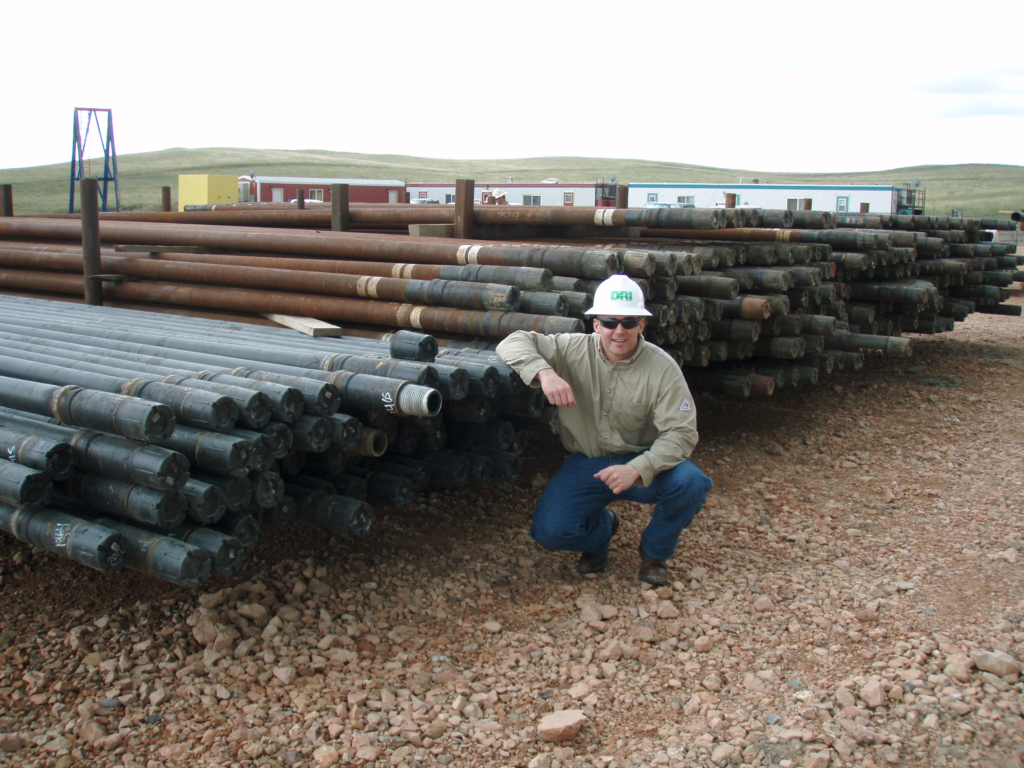What is a Drilling Rig Floorhand?
A drilling floorhand job is essential in the oil and gas rig industry. This entry-level position is a crucial part of a drilling crew, responsible for assisting in drilling equipment operations and maintenance on the rig floor. The floorhand duties & job description include performing various manual labor tasks in oil rigs. These tasks include connecting and disconnecting drill pipes, operating manual tongs, and assisting with transporting and handling drilling bits and other tools. They are also responsible for preventative maintenance and housekeeping activities to ensure the smooth functioning of the drilling rig components. Before starting, we recommend reading more about life on an oil rig.

This role requires physical stamina and the ability to work in a fast-paced environment. The floorhand must also have a mechanical aptitude and be able to work with power tools and heavy equipment. Safety is a top priority, and floorhands shall follow all safety protocols and use protective equipment. Being a drilling rig floorhand is an entry-level position offering valuable hands-on experience in the oil and gas industry.
Floorhand Job Description and Duties in Oil Rig
The job duties of a Drilling Rig Floorhand are crucial in ensuring the smooth operations of a drilling rig. They are responsible for various tasks related to rig operations, maintenance, cleaning, and drilling activities.
One of the primary responsibilities of a Floorhand is general maintenance and housekeeping activities on the rig floor. They perform preventative maintenance on equipment, including mud pumps, top drive, rig kelly, derrick, mast, BOP control unit, and any additional rig component. Furthermore, floorhands should ensure the cleanliness and organization of the rig floor. They should also report any equipment failure to the driller and toolpusher.

In addition, Floorhands assist in tripping pipes activities. These activities include connecting Bottom hole assembly, heavy-weight drill pipes, drill collars, drilling subs and drill pipes using manual tongs, drill slips, and other tools. They work in a fast-paced environment and are required to have the physical stamina to handle manual labor tasks.
Nipple up is one of the most essential duties for a rig floorhand. It involves connecting and disconnecting the wellhead & BOP. In addition, they assist other drilling services personnel to nipple up their equipment and tools. Therefore, rig floorhand must be knowledgeable in different nipple-up techniques, including manual tongs, power tongs, and pipe wrenches.
Safety is a top priority for a Floorhand, as they will work with power tools and heavy equipment. They are responsible for wearing and maintaining safety equipment, following safety procedures. In addition of that, they shall ensure a safe work environment for themselves and their team members. Furthermore, reporting for any unsafe acts is one of their responsibilities.
Skills Needed to be a Drilling Rig Floorhand
Several vital skills and abilities are essential for a successful Floorhand in the oil and gas industry. First and foremost, a solid mechanical aptitude is crucial. Floorhands must understand how drilling equipment functions and be able to troubleshoot and perform routine maintenance on the equipment.
Physical stamina is also vital as this role involves manual labor tasks that can be physically demanding. In oil rig, Floorhands need to be able to handle the physical requirements of the job, including lifting heavy objects and working in extreme weather conditions.

Problem-solving abilities are another critical skill for a Floorhand. They must quickly identify and address any maintenance issues and find solutions to any challenges that may arise during drilling operations.
Floorhands also work in a team-oriented environment, so practical teamwork skills are necessary. They must work collaboratively with other crew members and communicate effectively to ensure smooth and efficient drilling operations.
Additionally, strong communication skills are essential for a Floorhand. They need to communicate clearly and effectively with other crew members and follow instructions accurately.
In summary, to excel as a Floorhand, individuals must possess mechanical aptitude, physical stamina, problem-solving abilities, teamwork skills, and strong communication skills. These skills are crucial for maintaining equipment, performing manual labor, and ensuring successful drilling operations in a fast-paced and challenging environment.
Qualifications for Becoming a Floorhand
Becoming a Floorhand on an oil rig requires physical strength, problem-solving abilities, teamwork, and strong communication skills. This entry-level position is physically demanding, and candidates must possess excellent physical stamina to handle the manual labor tasks involved, such as lifting heavy objects and working in extreme weather conditions.
Identifying and solving maintenance issues quickly is vital, as well as having the ability to problem-solve and find solutions during drilling operations. Floorhands must also be team players, working collaboratively with crew members and effectively communicating to ensure smooth and efficient drilling operations.
Strong communication skills are necessary to follow instructions accurately and effectively communicate with other team members. Overall, the qualifications for becoming a Floorhand involve a unique combination of physical capabilities, problem-solving abilities, teamwork skills, and effective communication.
Education Requirements
Becoming a drilling rig floorhand typically requires a high school diploma or equivalent education. While no specific educational requirements exist beyond this, some preferred qualifications can enhance your chances of securing a position in this role.
Preferred qualifications may include technical or vocational training in the oilfield services industry. This can give you a better understanding of drilling operations and the equipment used on the rig floor. Additionally, any experience in an entry-level position within the oilfield or relevant fieldwork can also be beneficial.
While a formal education beyond high school may not be required, one must possess the necessary skills and abilities to perform the job’s essential functions. This may include physical labor, manual handling, using power tools, and heavy equipment. It may also be necessary to perform routine maintenance and housekeeping activities and work in inclement weather conditions.
Overall, while formal education beyond high school may not be necessary to become a drilling rig floorhand, having technical or vocational training and relevant experience in the oil field can increase your chances of success in this fast-paced and physically demanding role.
Physical Requirements
As a drilling rig floorhand, physical requirements are crucial to the job duties. This role involves various physically demanding tasks, such as manual labor and operating rig equipment. You will be responsible for connecting and disconnecting the drill pipe and using manual tongs to secure the drill pipe and drill bits.

In addition to the physical demands, it is vital to comply with DOT Regulations and Health & Safety requirements. This includes following proper procedures for lifting and moving heavy objects and wearing the appropriate protective equipment to ensure personal safety. This may include CSA-approved steel-toed boots, coveralls, hard hats, safety glasses, and impact gloves.
The nature of the job also means working in various weather conditions, from extreme heat to inclement weather. This necessitates being prepared with the required work gear for different seasons. Having the necessary gear to protect yourself and maintain a safe work environment is essential.
In conclusion, physical requirements for a drilling rig floorhand are significant. You must be physically fit and capable of performing manual labor tasks, operating rig equipment. In addition, it is necessary to follow health and safety protocols. By wearing the appropriate work gear and working in compliance with regulations, you can ensure a safe and productive work environment.
Previous Experience Necessary
Previous experience is typically necessary for individuals seeking to become a Drilling Rig Floorhand. While some oil and gas companies may offer entry-level positions that require minimal experience, most employers prefer candidates with relevant work experience or training programs.
Gaining experience on a land-based rig is often a common practice before advancing to a floorhand position. This experience allows individuals to familiarize themselves with the rig floor, drilling equipment, and manual labor tasks commonly performed in the oilfield services industry. It also provides an opportunity to develop preventative and routine equipment maintenance skills.
Those with previous experience in the field may know drilling operations, drill floor protocols, and the use of power tools. Additionally, experience working with drilling pipes, drill bits, and manual tongs is highly beneficial.
To enhance their chances of securing a floorhand position, individuals can also consider participating in training programs specifically designed for the oilfield services industry. These programs provide participants with the necessary skills and knowledge to excel in a fast-paced, team-oriented environment.
Overall, having previous experience or participating in relevant training programs can significantly increase an individual’s chances of obtaining a Drilling Rig Floorhand position.
Working Conditions of a Floorhand
As a floorhand on an oil rig, individuals can expect to work in a challenging environment that requires physical labor and the ability to adapt to various weather conditions. The job often involves manual handling tasks like connecting drill pipes and operating manual tongs.
They may also be required to perform routine maintenance on equipment and address any maintenance issues that arise. The work can be physically demanding, and individuals must withstand extreme heat or inclement weather conditions. Despite the challenging nature of the job duties, floorhands are typically provided with the necessary safety equipment to ensure a safe work environment.
Fast-Paced Environment

Source: wikipedia
A drilling rig floorhand must thrive in a fast-paced environment where work needs to be performed efficiently and time-sensitive. The rig operates 24 hours a day, and the nature of the job requires quick decision-making and exceptional multitasking skills.
Working in a fast-paced environment also means working efficiently and accurately while meeting deadlines. The floorhand must be able to prioritize tasks and manage their time effectively to ensure that drilling operations continue without delay.
In conclusion, the fast-paced environment of a drilling rig floorhand demands quick decision-making, multitasking skills, and the ability to perform various manual tasks efficiently. Adaptability and effective communication are also crucial to meeting deadlines and running operations smoothly.
Manual Labor Tasks Involved in the Job
As a drilling rig floorhand, you can expect to perform various manual labor tasks throughout the rig site. These tasks are essential to ensure the smooth operation of drilling activities. One of the manual labor tasks you will be responsible for is rig up and down activities, which involves assembling and disassembling drilling equipment and structures. This includes setting up pipe racks, putting together the rig floor, and assisting with installing drilling pipes.
As a floorhand, you will also be involved in general equipment repairs and maintenance. This may include conducting routine maintenance checks, troubleshooting equipment issues, and assisting with preventative maintenance activities. Your role may also encompass mud-mixing duties, where you will be responsible for preparing and monitoring drilling fluid types used in the drilling process.
Furthermore, carrying out assigned activities on the rig floor or the derrick would be best. These tasks can range from handling drill pipes, connecting and disconnecting drill tools to performing manual handling tasks.
In summary, drilling rig floorhand involves various manual labor tasks such as rig up and down activities, equipment repairs and maintenance, mud-mixing duties, and rig floor or derrick activities. These tasks are vital in facilitating drilling operations and ensuring a safe and efficient work environment.
Safety Practices Necessary on the Rig Floor
Safety practices are paramount on the rig floor, ensuring the well-being of all workers. Protective equipment such as hard hats, safety glasses, steel-toed boots, and gloves are essential to shield against potential hazards. Risk assessment is necessary for manual handling tasks involving lifting heavy objects or equipment. Proper techniques, such as bending the knees and using the legs to lift, should be followed to prevent strains and injuries.
Working near heavy tools and moving machinery requires utmost caution. Workers must remain vigilant and aware of their surroundings, avoiding potential contact with these objects. Clear communication between team members is crucial to prevent accidents.
Working in all weather conditions can present specific hazards. Extreme heat or cold can lead to fatigue or hypothermia, so workers should dress appropriately and stay hydrated. Extra caution is necessary to prevent slips, trips and falls on slick surfaces, such as when it rains or in icy conditions. Wearing appropriate footwear with good traction and using slip-resistant mats can help mitigate these risks.
Overall, safety practices on the rig floor encompass protective equipment, risk assessment for manual handling tasks, and precautions for working near heavy tools and moving machinery. Furthermore, knowing the hazards of working in all weather conditions and on slick surfaces is vital to maintaining a safe work environment.
Equipment Used by a Floorhand on Drilling Rig
As a floorhand on an oil rig, you will work closely with various types of equipment to ensure the efficient operation of drilling activities. Some of the standard equipment floorhand uses include pipe slips, manual tongs, drilling bits, power tools, rig elevators, wrenches, and power tongs. Floorhands are responsible for connecting BHA sections, assisting in maintaining rig equipment, and carrying out routine maintenance tasks.
Power Tools and Manual Tongs Used on the Drill Floor
Power tools and manual tongs are essential equipment used on the drill floor of oil rigs. These tools help facilitate the drilling operations and ensure the smooth and safe handling of drilling string and equipment. Here are some commonly used power tools and manual tongs on the drill floor:
1. Power tools: Power wrenches, also known as tuggers or impact wrenches, tighten and loosen the threaded connections on the drilling pipe. They provide the torque required to secure these connections, saving time and effort compared to manual methods.

Get this image on: Shutterstock | License details Creator: James Jones Jr
2. Manual tongs: There are different types of manual tongs used on the drill floor, including casing tongs, drill pipe tongs, and tubing tongs. These tongs have jaws that grip and turn the pipe during various drilling operations. The floorhand manually operates them and comes in various sizes to handle different pipe sizes.
Functions and usage: Power tools, such as power wrenches, are powered by electricity or compressed air and are used for quick and efficient make-up and break-out of tubular connections. Manual tongs, on the other hand, use manual labor to provide a firm grip and rotation of the pipe during the make-up or break-out of connections. They require the floorhand to handle and secure the pipe using the tong jaws physically.
Drilling Pipes, Bits, and Accessories Used on the Rig
1. Drill Pipes: Drill pipes are tubular sections used to connect the drilling rig surface equipment with the drilling bit. They are typically high-strength steel and have threaded connections on each end for easy assembly and disassembly. Drill pipes provide the conduit for transmitting drilling fluid, also known as mud, to the drill bit. They also support the weight of the drill string and allow for the power transmission required for drilling operations.

2. Drill Bits: Drill bits are cutting tools attached to the end of the drill pipe. Their primary function is to create a borehole by breaking and crushing the rock formation. Various types of drill bits are designed for specific drilling conditions, including roller cone bits, polycrystalline diamond compact (PDC) bits, and diamond bits. The choice of drill bit depends on factors like the hardness of the rock, drilling depth, and desired hole cleaning.

3. Accessories: Several accessories, along with drill pipes and bits, are commonly used on a drilling rig. These include stabilizers, reamers, mud motors, and drilling jars. Stabilizers are used to maintain the verticality of the wellbore and prevent deviation during drilling. Reamers are used to enlarge the hole after the initial drill bit passes. Mud motors convert hydraulic energy from drilling fluid into mechanical rotational energy, providing additional power to the drill bit—drilling jars free stuck drill strings by applying an upward mechanical shock.
Drilling pipes, bits, and accessories are essential components of a drilling rig, enabling the efficient and effective drilling of boreholes for various purposes, such as oil and gas drilling rigs, mineral extraction, and geotechnical investigations.
Connecting Drill Pipe Operated by Hand or with Machinery
This process can be done either by hand or with the assistance of machinery. When connecting drill pipes by hand, floorhands utilize manual tongs and specially designed wrenches to tighten the threaded connections. They carefully align grease and thread the connections, ensuring a secure and leak-free joint.
Alternatively, machinery such as power tongs can be used to make the connection process more efficient. Power tongs are automatic wrenches that can quickly and accurately tighten the connections with the help of hydraulic power. This minimizes manual labor and reduces the risk of injuries.
Drilling Rig Floorhand Jobs

Several top websites offer job vacancies if you are looking for rig floorhand jobs. Some popular websites owned by drilling rig companies include Precision Drilling Corporation, Savanna Drilling LLC, Nabors Industries Ltd, and Deep Water. These websites provide various job opportunities for individuals interested in becoming rig floorhands.
You might find a lot of opportunities on the following websites:
Drilling Rig Floorhand Salary
The salary range for Rig Floorhands can vary depending on experience, location, and industry. According to Glassdoor, On average, Floorhands in the United States earn an annual salary between $38,000 and $50,000; in Canada, the range is between CAD 43,000 and CAD 54,000 per year.
The US’s highest-paying cities for Rig Floorhands include Midland, Texas; Houma, Louisiana; and Fort Collins, Colorado. In these cities, Floorhands can earn salaries higher than the national average due to the high demand for workers in the oil and gas industry.
Floorhands in offshore drilling rigs earn higher salaries than those working on land-based drilling rigs. The median salary for Floorhands in the offshore industry is around $55,000 annually.
Expected benefits offered to Floorhands in the oilfield services industry include health insurance, retirement plans, vacation and paid time off, and opportunities for career advancement. Employers also provide safety equipment and training to ensure a safe work environment for Floorhands.
In summary, Rig Floorhands can expect competitive salaries within the oil and gas industry. The highest-paying cities and offshore positions offer higher salaries, while benefits such as health insurance and retirement plans are commonly provided.